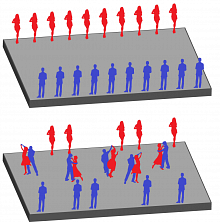Apr 26 2014
Scientists at SLAC National Accelerator Laboratory and Stanford University have shown for the first time how high-temperature superconductivity emerges out of magnetism in an iron pnictide, a class of materials with great potential for making devices that conduct electricity with 100 percent efficiency.
 A SLAC/Stanford study reveals how high-temperature superconductivity emerges out of magnetism in an iron pnictide. At first the material’s electrons line up with their spins pointed in specific directions, a hallmark of magnetism. But as the temperature drops, a few electrons pair up, like dancers at a party, to effortlessly conduct electricity; then a few more; until finally all the active electrons find partners and the material is fully superconducting. (Ming Yi/Stanford University)
A SLAC/Stanford study reveals how high-temperature superconductivity emerges out of magnetism in an iron pnictide. At first the material’s electrons line up with their spins pointed in specific directions, a hallmark of magnetism. But as the temperature drops, a few electrons pair up, like dancers at a party, to effortlessly conduct electricity; then a few more; until finally all the active electrons find partners and the material is fully superconducting. (Ming Yi/Stanford University)
In experiments at SLAC’s Stanford Synchrotron Radiation Lightsource (SSRL), the team “doped” the material – one of two known types of high-temperature superconductor – by adding or subtracting electrons to enhance its superconducting abilities. Then they used a beam of ultraviolet light to measure changes in the material’s electronic behavior as it was chilled to a temperature where superconductivity becomes possible.
The researchers saw the two states battle for dominance: At first the electrons in the material all lined up with their spins pointed in specific directions, a hallmark of magnetism. But as the temperature dropped, a few electrons paired up, like dancers at a party, to effortlessly conduct electricity; then a few more; until finally all the active electrons found partners and the material was fully superconducting, a much more complex behavior.
The results, published April 25 in Nature Communications, are an important step toward understanding how high-temperature superconductors work – information scientists need to realize their dream of engineering superconductors with more useful properties that operate at close to room temperature for a variety of practical applications.
Complexity Emerges from Simple Ingredients
“For a while both magnetism and superconductivity co-exist; that’s not a surprise,” said Ming Yi, a graduate student with the Stanford Institute for Materials and Energy Sciences (SIMES) and lead author of the report. “But we wanted to see how just these two phases interact with each other. Now we finally have the high-resolution tools we need to see these changes at a microscopic level, and we find that the same electrons that were participating in the magnetic order have switched over to participate in the superconducting order. These two orders compete for the same electrons.’’
Comparing their experimental data to the results of simulations, the researchers determined that the magnetism and superconductivity in iron pnictide were interwoven at a very fine, microscopic level, rather than occupying larger, separate puddles within the material. The simulations were led by theorists Lex Kemper of Lawrence Berkeley National Laboratory, Stanford graduate student Nachum Plonka and SIMES Director Thomas Devereaux.
“This is a beautiful example of ‘emergence,’ in which simple ingredients give rise to complex behavior,” said co-author Zhi-Xun Shen, a professor at SLAC and Stanford and SLAC’s advisor for science and technology. "Emergence is a major theme of modern research on organizing principles of nature,” he said. “Our hope is that research on quantum systems like this one, which are very simple model systems, will eventually give us insights into such organizing principles.”
Exploring a Mystery Material
Discovered in 1986, high-temperature superconductors carry electricity without any loss at much warmer temperatures than conventional superconductors, which have to be chilled to at least 30 kelvins (minus 243 degrees Celsius). Still, scientists have not been able to get high-temperature superconductors to operate above minus 138 degrees Celsius.
While these materials have the potential to save money and energy in a number of applications, from carrying electricity over long-distance power lines to operating maglev trains, the high cost and logistics of keeping them cold and their difficult-to-handle properties have held them back.
As in regular superconductors, electrons in high-temperature superconductors form pairs to conduct current. But the mechanism behind this pairing in the high-temperature materials – the “glue” that holds the electrons together – is still unknown, said Donghui Lu, a senior staff scientist at SSRL and one of the principal investigators for the study.
Another mystery: In theory, superconductivity and magnetism are not supposed to co-exist; the presence of one should drive out the other. But previous studies have shown they can in fact exist in the same material, and scientists have been eager to learn the details of how and why that happens.
While this study doesn’t answer those burning questions, it does give scientists a closer look at the details of what happens as superconductivity emerges.
The results may also shed light on the other known family of high-temperature superconductors, the copper-based cuprates, the scientists wrote, and comparing results from the two may lead to “an eventual understanding of the mechanism of unconventional superconductivity.”
In addition to SLAC and SIMES, which is a joint SLAC/Stanford institute, researchers from Stanford University, Lawrence Berkeley National Laboratory, Nanjing University, and the University of California-Berkeley contributed to this work. Some measurements were carried out at Berkeley Lab’s Advanced Light Source. The work at Stanford, SLAC and the Advanced Light Source was funded by the U.S. Department of Energy Office of Science.
Citation: M. Yi et al., Nature Communications 5, Article number:3711, doi:10.1038/ncomms4711